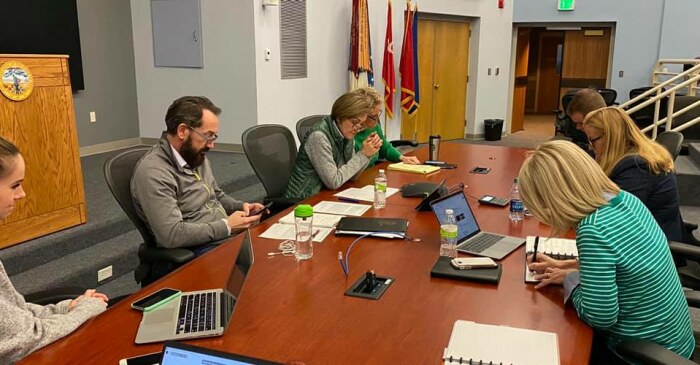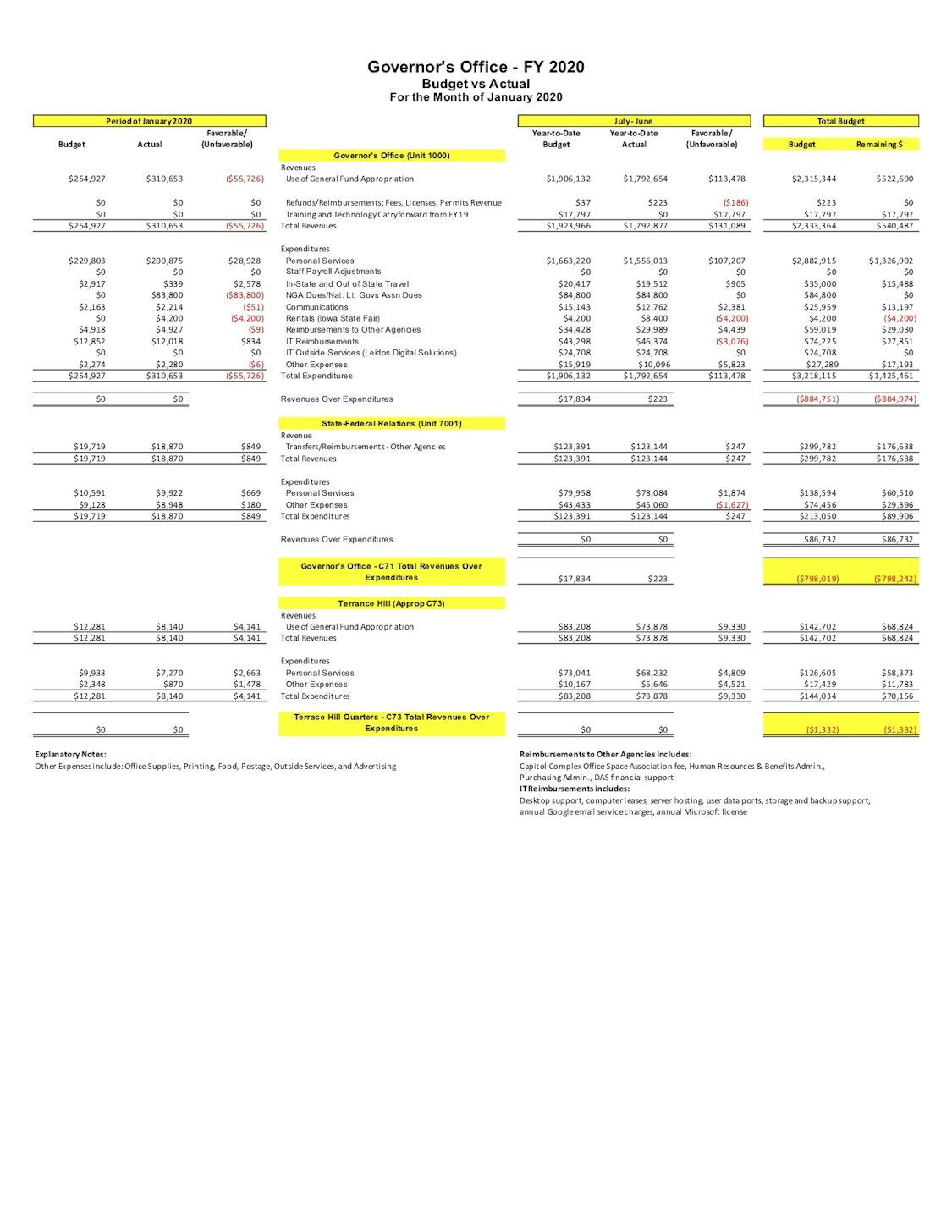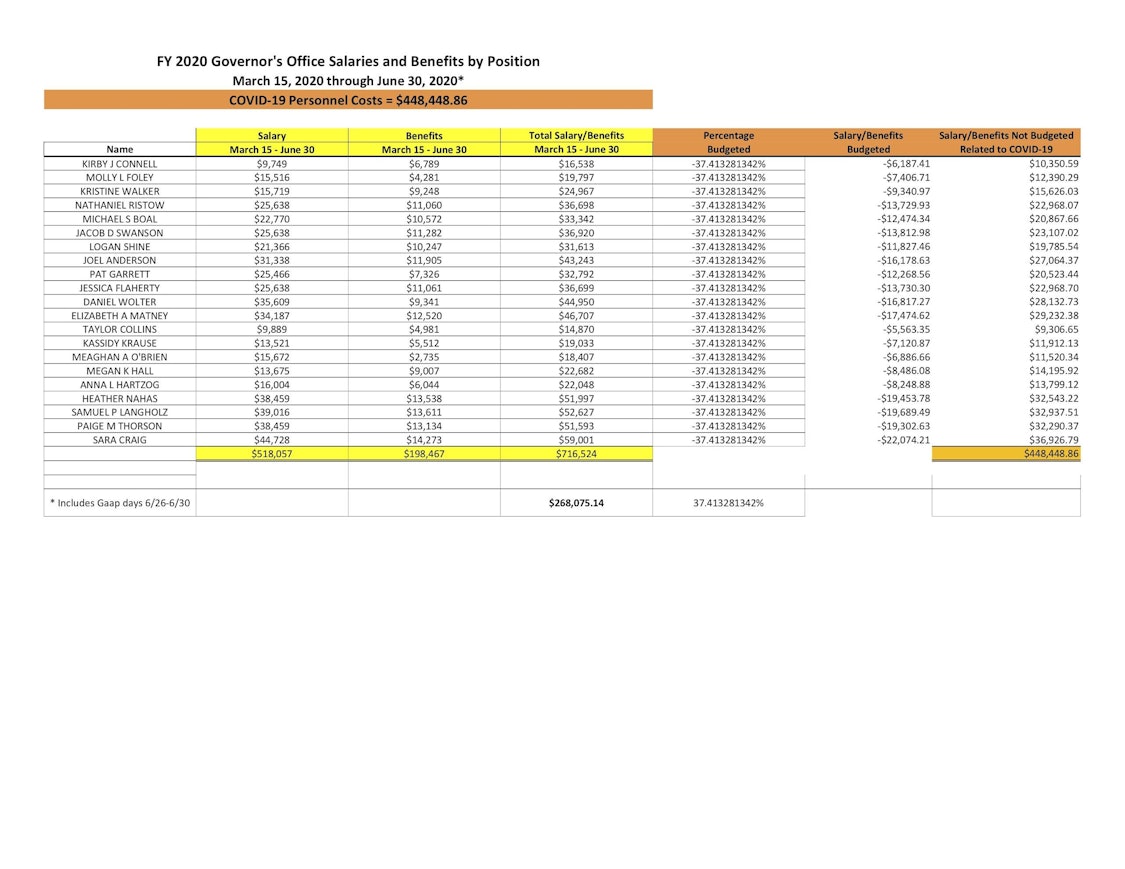Governor Kim Reynolds used $448,449 in federal COVID-19 relief funds to cover a shortfall in her office budget without documenting that 21 of her staffers were “substantially dedicated” to the pandemic response, a state audit determined.
The U.S. Treasury Department’s Office of Inspector General asked state auditors in January 2021 to review whether the spending complied with rules governing the use of Coronavirus Aid, Relief and Economic Security (CARES) Act funds. Bleeding Heartland was first to report in September 2020 on CARES Act payments supporting the governor’s permanent staffers, and reported exclusively last December on how documents were altered to make a “FY 2020 Shortfall” in the governor’s office budget appear to be “COVID-19 Personnel Costs.”
State Auditor Rob Sand warned the Reynolds administration in October 2020 that without adequate documentation, COVID-19 relief funds used to pay governor’s staff salaries might need to be repaid to the federal government. The report issued this week advised the governor to return the money to Iowa’s Coronavirus Relief Fund “for other eligible and supported uses prior to the December 31, 2021 deadline.”
The governor’s spokesperson Alex Murphy told reporters the office is “now working with Treasury to provide them documentation” to support the CARES Act spending.
That’s easier said than done.
GOVERNOR’S OFFICE FAILED TO DOCUMENT PANDEMIC-RELATED WORK
The findings about the governor’s use of CARES Act funds were part of the State of Iowa’s Single Audit Report for fiscal year 2020, released on November 15. That report covers all spending of state and federal funds and usually comes out in late March, but was severely delayed this year due to accounting problems at Iowa State University.
Here’s the relevant four-page section.
Federal guidance makes clear that CARES Act funds are allowed to cover “necessary expenditures incurred due to the public health emergency,” that “were not accounted for in the budget most recently approved” and were incurred between March 1, 2020 and December 31, 2021. Payroll expenses qualify if the employees were “substantially dedicated to mitigating or responding to the COVID–19 public health emergency.”
An expense can be considered “not accounted for in the budget” if “either (a) the cost cannot lawfully be funded using a line item, allotment, or allocation within that budget or (b) the cost is for a substantially different use from any expected use of funds in such a line item, allotment, or allocation.”
The state budget for fiscal year 2020 included a $2,315,344 line item for the governor’s office expenses, which would ordinarily include staff salaries and benefits. So to justify the use of CARES Act funds, the governor’s office would need to show its employees were engaged in “substantially different” work that was directly related to the public health emergency.
As Sand warned Iowa’s budget director in October 2020,
Salaries may qualify only when certain conditions are met. The work the Governor’s staff are doing that is directly related to the pandemic must be tracked separately from their ordinary work, and supported with appropriate documentation. Only then may that portion of their salaries qualify, and not if the work is only indirectly related to the pandemic.
The $448,449 transferred from the Coronavirus Relief Fund represented 62.59 percent of the 21 employees’ compensation from mid-March through June 2020. State auditors twice asked the governor’s office for evidence supporting those calculations.
In response to our request for this documentation, a spokesperson from the Office of the Governor stated that “during the March 15 through June 30 time period, the Office of the Governor was fully focused on responding and protecting Iowa from COVID. Like guidance used for other departments heavily focused on COVID response, the Office of the Governor assumed a percentage of time dedicated to pandemic response.” […]
The Office of the Governor has not established policies and procedures to require documentation to support a ‘substantially dedicated’ conclusion with respect to its employees or to support how the 62.59% was assumed or determined, including requiring support for actual hours spent by each employee for time dedicated to mitigating or responding to the COVID-19 public health emergency.
In a statement provided to Bleeding Heartland and other reporters, Reynolds’ spokesperson Alex Murphy asserted that the Treasury Department
confirmed that the use of Coronavirus Relief Funds to reimburse the salaries and benefits of a governor’s staff is an allowable expense.
During this time, the Governor’s staff spent a vast majority of their time responding to the pandemic. In fact, many members of Gov. Reynolds’ staff worked seven days a week out of the State Emergency Operation Center to provide direct support to Iowans. This has always been our justification for the expense.
We are now working with Treasury to provide them documentation, per their request.
But working from the State Emergency Operation Center doesn’t automatically transform staff salaries into qualifying expenses. Treasury’s guidance says “a public function does not become a ‘substantially different use’ merely because it is provided from a different location.”
In addition, U.S. Treasury’s Deputy Inspector General Richard Delmar told Bleeding Heartland via email on November 16 that his office is not working directly with the governor’s staff to substantiate the CARES Act spending.
The State Auditor is conducting work required by the Single Audit Act, and is responsible for reviewing and concluding on any additional documentation provided by the State in response to the State Auditor’s finding. Treasury Office of Inspector General has not initiated an audit of the Governor’s Office salaries and awaits resolution of this matter between the Iowa State Auditor and the Governor’s Office.
Delmar said documents showing that staff were “substantially dedicated to the pandemic-related activities” might include “time and attendance records, decision memoranda, new and/or updated directives and policies applicable to CRF charges, meetings and meeting minutes, email correspondence, and calendar information, indicating the nature of the issues on which these employees were engaged.”
But he confirmed, “The State Auditor will assess the adequacy and sufficiency of supporting documentation as part of its audit.”
According to the report published this week, “On November 1, 2021, the Treasury OIG reviewed and concurred with this finding. Also, the Treasury OIG informed this Office they had met with representatives from the Office of the Governor and told them the same.”
Based on this communication from Treasury OIG, the use of CARES funds for Governor’s staff salaries would only be allowable if contemporaneous documentation (documentation existing at the time the expenses were incurred) were submitted by the Office of the Governor to support the expenses. In addition, the work would need to directly, not indirectly, support the pandemic response.
In a November 16 telephone interview, Sand asked, “If they have that documentation, why wasn’t it provided to our office the two times we asked for it?”
Good question. And that’s not the only problem.
BUDGET SHORTFALL WAS BAKED IN BEFORE PANDEMIC
CARES Act funds were “not intended to be used to cover government payroll expenses generally,” federal guidance explained. They were “intended to provide assistance to address increased expenses, such as the expense of hiring new personnel as needed to assist with the government’s response to the public health emergency and to allow recipients facing budget pressures not to have to lay off or furlough employees who would be needed to assist with that purpose.”
Reynolds didn’t hire a bunch of new staff to help with COVID-19 matters. State auditors reviewed payroll records and found 20 of the 21 employees were working in her office prior to the pandemic, and none received raises between March and June 2020. Their salaries were “approved and expected prior to any knowledge of a Pandemic.”
The audit added, “What is not clear, is why these salaries were not included in the Governor’s budget set prior to the fiscal year and prior to the Pandemic. Based on this information, we conclude that the budget shortfall was not a result of the Pandemic.”
That’s correct. Monthly budget reports for the governor’s office from the 2020 fiscal year, which Bleeding Heartland published last December, show the governor’s office was on track to spend far more than its budget appropriation before COVID-19 arrived in Iowa. By way of example, here’s the report covering January 2020. (Numbers may be hard to read on a small screen, but you can download the pdf file here.)
Note that even though the state budget appropriation was $2,315,344, the governor’s office expected to spend more than $3.2 million during the fiscal year, of which nearly $2.9 million would cover “personal services” (staff salaries).
If there had been no pandemic, Reynolds would have needed to cover that budget shortfall some other way. Probably she would have pushed more staff salaries onto other state agencies, which is how her office balanced its books for fiscal year 2021 (July 2020 through June 2021).
The most damning evidence in the state auditor’s report stemmed from efforts to conceal the use of CARES Act funds to pay Reynolds’ staffers.
ATTEMPT TO HIDE CARES ACT SPENDING PRODUCED SMOKING GUN
Reynolds asserted last September, “CARES funding can be used for salaries. That’s very clear in what allowable allocations are.”
I’ve long wondered: if the governor was so sure her staff’s salaries qualified as an expense, why did her office go to so much trouble to hide the spending?
I learned on August 26, 2020 that CARES Act funds “supplemented the full salaries and benefits” of 21 governor’s office employees from March 14 through June 30, 2020. I first asked Reynolds’ spokesperson Pat Garrett about those expenditures on August 28.
Records I obtained later showed that on September 2, 2020, the governor authorized a $1 million transfer from the Coronavirus Relief Fund to the Homeland Security and Emergency Management Department “for COVID-19 staffing.”
Homeland Security officials hadn’t requested the money and weren’t expecting it. After the transfer was executed on September 9, senior agency staff were surprised the money landed in their fiscal year 2020 account. They didn’t learn about the plan to use $448,448.86 to cover personnel costs in the governor’s office until September 14.
The new state audit includes tables provided by the Homeland Security department, which Bleeding Heartland was first to publish last December. They show that staff at the Iowa Department of Management (the state’s budget agency) calculated that $448,448.86 was the governor’s office “FY 2020 Shortfall Per I/3 Finance.” The same amount was needed “to Balance Appropriation.” It worked out to 62.59 percent of each staffer’s compensation during those three and a half months.
Email correspondence Bleeding Heartland obtained through a public records request last year showed that a Homeland Security employee suggested changing the headings on that table to indicate that the spending was COVID-19 related.
The revised headings made it appear that the governor’s office fiscal year 2020 shortfall was in fact “COVID-19 Personnel Costs,” and that “Revised Salary/Benefits to Balance Appropriation” were “Salary/Benefits Not Budgeted Related to COVID-19.”
The state audit concluded, “based on the information provided in Tables 1 through 4, it appears more likely the CARES funds were used to cover a budget shortfall that was not a result of the pandemic.” Sand told David Pitt of the Associated Press, “That spreadsheet that shows they changed the headers to basically instead of say shortfall to say COVID 19 is a pretty big deal.”
I thought so too. And those documents would not exist if Reynolds’ team had not decided to run the money through Homeland Security, an indirect payment scheme not used for any other CARES Act expenditure.
Homeland Security’s “State Government COVID Staffing” account served no purpose other than to obscure the ultimate beneficiary of CARES Act dollars designated for the governor’s office. Because the $448,449 was recorded as an intra-state transfer, published state reports on pandemic spending didn’t and still don’t show any money going to the governor’s office.
Reynolds never allocated the remaining $551,551.14 designated for “State Government COVID Staffing.” Homeland Security returned those unspent funds to the Coronavirus Relief Fund in April 2021.
THE STAFFER NOT PAID WITH CARES ACT FUNDS
Like the dog that didn’t bark in a famous Sherlock Holmes story, one person who was not compensated with CARES Act funds merits attention.
Arguably no one on Reynolds’ staff was more deeply involved with Iowa’s COVID-19 response than chief operating officer Paul Trombino III. Here he is at the governor’s side in the State Emergency Operations Center on March 17, 2020.
Trombino was the lead negotiator on the state’s no-bid Test Iowa contract and signed other no-bid contracts related to COVID-19 testing and the state’s coronavirus dashboard. He conferred with counterparts in other states on various pandemic policies. He was copied on many email chains involving Iowa Department of Public Health senior staff. In June 2020, he orchestrated a 45 percent pay raise for Iowa’s State Medical Director Dr. Caitlin Pedati, in violation of state policy at the time.
Yet Trombino was not among the 21 staffers in Reynolds’ office who were partly compensated through CARES Act funds between March and June 2020.
Why not? I started asking the governor’s office about this last September and never got an answer.
I learned through other inquiries that the Department of Administrative Services paid 100 percent of Trombino’s salary and benefits after Reynolds named him interim director on March 7, 2020. That agency reimbursed the governor’s office $63,952 for Trombino’s work during the 2020 fiscal year and transferred another $106,993.07 to the governor’s office early this year to cover Trombino’s salary and benefits from July 1, 2020 through January 10, 2021. (Reynolds appointed a new director on January 11.)
Although the state audit doesn’t mention Trombino, his salary arrangement supports the conclusion that tapping CARES Act funds was never about which of Reynolds’ staffers were actually working on pandemic matters. It was just a way to balance the books after the governor overspent her budget appropriation. They didn’t need to put part of Trombino’s compensation on the federal government’s tab, because that expense had already been outsourced to another state agency.
UPDATE: Rod Boshart reported for the Cedar Rapids Gazette on November 23,
“We feel very, very confident that we can provide the documentation that shows that we were working 100 percent of our time on COVID-19 because the projections were horrific,” the governor said in discussing relief funds that Iowa Auditor Rob Sand contends were used improperly.
Reynolds said the issue focused on intensive work that was being done by all state government agencies in March, April and May 2020 to fully focus on responding to COVID-19.
“We’ll have no problem in providing them the documentation they need,” she told reporters Tuesday. “I don’t think there was probably a governor in the country that wasn’t working 100 percent of their time on COVID.”
Kathie Obradovich covered the same event for Iowa Capital Dispatch.
“And because we were working on COVID, 100 percent of the time, we didn’t think that it was fair for the agencies to pay for the team, because we weren’t working on policy-specific issues that was related to each one of the agencies,” Reynolds said. “We were actually working on COVID and trying to make sure that we were keeping Iowans safe, and that we were really making sure that we weren’t overwhelming our health care system.”
That doesn’t explain why Reynolds didn’t use CARES Act funds to pay Trombino. Why was it “fair” to push 100 percent of his salary and benefits from early March 2020 through early January 2021 onto the Department of Administrative Services?
Top image: Governor Kim Reynolds working with staff in the State Emergency Operations Center on March 17, 2020. Her office’s chief operating officer Paul Trombino is seated to her right. Photo first posted on the governor’s official Facebook page.





